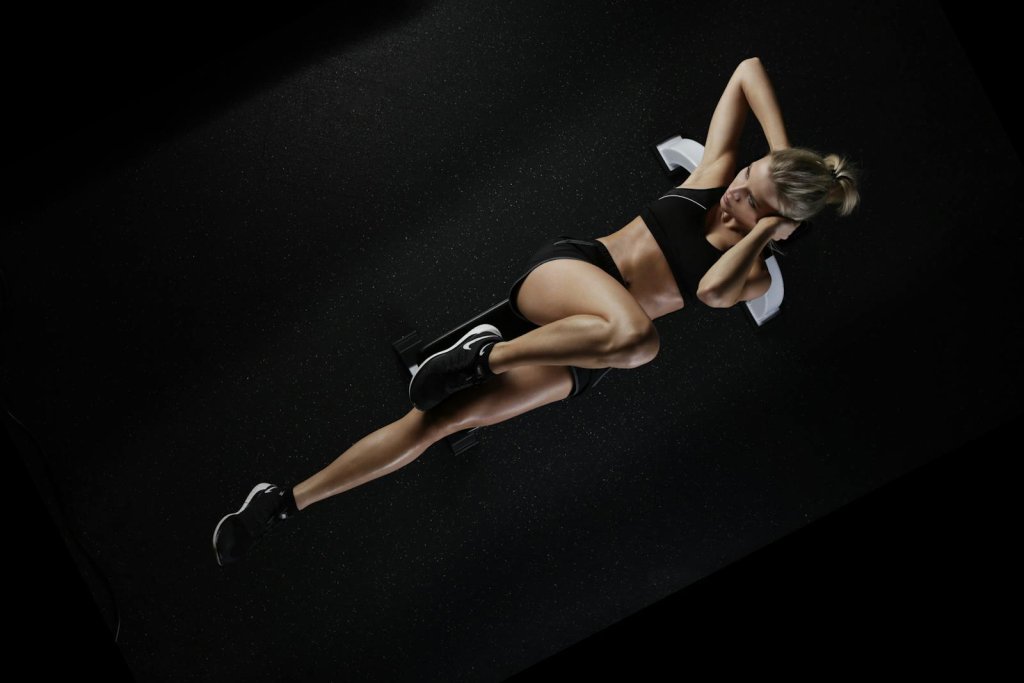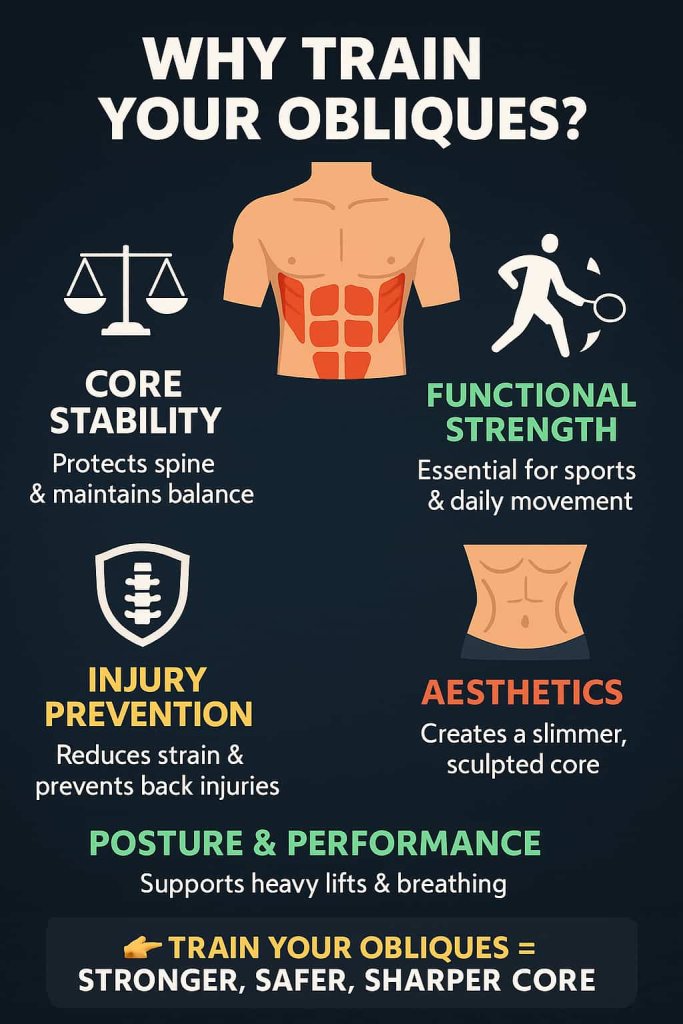Yes, oblique workouts are one of the fastest ways to build a sculpted core and improve stability. These side-ab muscles—your internal and external obliques—are responsible for rotation, side bending, and overall torso strength. Training them regularly not only slims your waistline but also protects your spine, improves posture, and boosts athletic performance.

In this guide, we’ll cover the 20 best oblique workouts that combine side planks, rotational moves, bodyweight crunches, and weighted exercises. Whether you train at home or in the gym, you’ll find bodyweight, dumbbell, and cable variations to build a strong, defined midsection.
Why Train Your Obliques?
The obliques are often neglected compared to the rectus abdominis (“six-pack muscles”), but they are just as important:

- Core Stability → Obliques protect your spine and help maintain balance.
- Functional Strength → Crucial for sports requiring rotation (tennis, golf, baseball).
- Injury Prevention → Reduces risk of lower back strain.
- Aesthetics → A V-tapered waistline and defined side abs complete your core look.
- Posture & Performance → Supports heavy lifts and improves breathing mechanics.
20 Best Oblique Workouts
Training your obliques isn’t just about building a slimmer waistline—it’s about rotational power, spinal stability, and injury prevention. The obliques (internal + external) are critical for every twist, side bend, and athletic movement you do. Below are the 20 most effective oblique exercises, from beginner-friendly crunches to advanced cable and landmine variations.
1. Side Plank (Classic & Weighted)
How to do it: Lie on one side, stack your feet, and prop yourself on your forearm. Lift your hips until your body forms a straight line. Hold 20–60 seconds.
Muscles worked: Obliques, transverse abdominis, shoulders.
Trainer Tip: Once bodyweight feels easy, place a dumbbell or plate on your hip for added resistance.
Why It Works: Builds static endurance in the obliques, essential for posture and stability.
2. Side Plank with Hip Dips
How to do it: From side plank, lower hips toward the floor, then lift back up. Repeat for reps.
Muscles worked: Obliques, glutes.
Best For: Adding dynamic movement to target endurance and time under tension.
Trainer Tip: Move slowly—avoid bouncing hips off the floor.
3. Side Plank with Rotation
How to do it: From side plank, extend your top arm to the ceiling. Thread it underneath your torso, rotating naturally, then return to start.
Muscles worked: Obliques, core stabilizers, shoulders.
Why It Works: Builds rotational strength—key for sports like golf, tennis, and baseball.
4. Oblique Crunches
How to do it: Lie on your side, knees bent. Place your top hand behind your head, and crunch your torso sideways.
Muscles worked: External obliques.
Trainer Tip: Don’t yank your neck—focus on torso movement.
Why It Works: Simple and effective for isolating the side abs.
5. Bicycle Crunches
How to do it: Lie on your back, hands behind head. Pedal legs in the air, bringing opposite elbow to knee.
Muscles worked: Obliques, rectus abdominis, hip flexors.
Evidence: EMG studies consistently rank bicycles among the highest for oblique activation.
Trainer Tip: Keep your lower back pressed into the floor.
6. Russian Twists (Weighted or Bodyweight)
How to do it: Sit at 45°, heels lifted or anchored. Rotate torso side to side, tapping floor with hands or a weight.
Muscles worked: Obliques, deep core stabilizers.
Trainer Tip: Avoid only moving your arms—rotate your whole torso.
Variation: Try with a medicine ball, plate, or kettlebell.
7. Jackknives
How to do it: Lie flat, arms extended overhead. Simultaneously raise legs and torso to meet in a “V.”
Muscles worked: Obliques, rectus abdominis.
Why It Works: Trains the entire core with extra emphasis on rotational stability.
Trainer Tip: Keep reps slow and controlled to avoid momentum.
8. Standing Side Crunches
How to do it: Stand tall, hands behind head. Crunch elbow down to meet same-side knee.
Muscles worked: Obliques, hip flexors.
Best For: Beginners and low-impact oblique training.
Trainer Tip: Keep chest lifted—avoid slouching forward.
9. Standing Side Bends (Dumbbell or Kettlebell)
How to do it: Hold a dumbbell or kettlebell in one hand at your side. Bend torso sideways as far as comfortable, then return.
Muscles worked: Obliques, erector spinae.
Trainer Tip: Keep torso straight—don’t lean forward or back.
Why It Works: Perfect for weighted progressive overload of the obliques.
10. High-to-Low Cable Woodchopper
How to do it: Attach cable at high setting. Stand sideways, pull handle diagonally across body from high to low.
Muscles worked: Obliques, serratus anterior, core stabilizers.
Trainer Tip: Keep arms straight—rotate through torso, not just shoulders.
Why It Works: Resistance follows the natural oblique muscle fibers.
11. Low-to-High Cable Woodchopper
How to do it: Set cable at low position. Pull diagonally upward across body.
Muscles worked: Obliques, lats, transverse abdominis.
Best For: Building full-range diagonal core strength.
Trainer Tip: Control both directions of the movement.
12. Landmine Rotations
How to do it: Place barbell in landmine setup. Hold bar with both hands, rotate side to side in an arc.
Muscles worked: Obliques, abs, shoulders.
Focus: Builds rotational power for athletes and fighters.
Trainer Tip: Keep hips square—rotate through torso.
13. Side Plank with Leg Lift
How to do it: Get into side plank. Raise top leg toward ceiling and hold briefly.
Muscles worked: Obliques, glutes, hip stabilizers.
Why It Works: Dual activation of obliques + glute medius.
Trainer Tip: Don’t let hips drop while lifting leg.
14. V-Ups with Twist
How to do it: Perform a V-Up but rotate toward one side at the top. Alternate sides.
Muscles worked: Obliques, hip flexors, rectus abdominis.
Trainer Tip: Keep core braced—avoid jerking upward.
15. Side Jackknife
How to do it: Lie on your side with hand behind head. Simultaneously lift legs and torso toward each other.
Muscles worked: Obliques (isolation).
Focus: Extremely intense contraction for side abs.
Trainer Tip: Move slowly for maximum burn.
16. Hanging Oblique Knee Raises
How to do it: Hang from pull-up bar. Bring knees diagonally toward elbow.
Muscles worked: Obliques, lower abs, grip.
Advanced Option: Keep legs straight and rotate them across body.
Trainer Tip: Don’t swing—keep controlled tempo.
17. Seated Oblique Crunch (Chair or Bench)
How to do it: Sit on edge of chair, lean back slightly. Crunch torso sideways toward hip.
Muscles worked: Obliques, rectus abdominis.
Best For: Beginners and home-friendly core workouts.
18. Stability Ball Oblique Crunch
How to do it: Lie on stability ball with lower back supported. Perform crunch with torso rotated to one side.
Muscles worked: Obliques, core stabilizers.
Why It Works: The instability of the ball forces deeper muscle recruitment.
19. Medicine Ball Slam (Side Variations)
How to do it: Hold ball overhead. Slam it diagonally toward the floor beside your body. Alternate sides.
Muscles worked: Obliques, shoulders, lats.
Athletic Benefit: Builds rotational explosiveness and power transfer.
Trainer Tip: Use a non-bouncing ball for safety.
20. Mountain Climbers with Twist
How to do it: In plank, drive knees across toward opposite elbow in running motion.
Muscles worked: Obliques, abs, shoulders.
Best For: Oblique activation + cardio conditioning.
Trainer Tip: Keep hips low—don’t let them bounce up.
Expert Tips for Training Obliques in 2025
- Train obliques 2–3 times per week.
- Mix static holds (planks) with dynamic movements (twists, crunches).
- For fat loss and definition, pair workouts with overall calorie deficit and cardio—you can’t spot-reduce fat.
- Focus on form, not speed: quality reps > rushed reps.
- Use standing oblique variations for functional, spine-friendly training (recommended by Woman & Home, 2025).
Sample Oblique Workout (At-Home)
| Exercise | Sets | Reps/Time |
|---|---|---|
| Side Plank | 3 | 30 sec/side |
| Russian Twists | 3 | 20 reps |
| Bicycle Crunches | 3 | 15 reps/side |
| Standing Side Bends | 3 | 12 reps/side |
| Mountain Climbers (Twist) | 3 | 30 sec |
FAQs About Oblique Workouts
1. Can oblique workouts slim my waist?
Yes, they strengthen and define the obliques, but visible results require overall fat loss through diet and cardio.
2. How often should I train my obliques?
2–3 times per week, balanced with rectus abdominis and transverse abdominis training.
3. Are standing oblique exercises effective?
Yes, they are joint-friendly, functional, and highly effective for daily movement patterns.
4. Do oblique workouts help with posture?
Absolutely. Strong obliques support the spine and reduce lower back strain.
5. What equipment is best for oblique training?
Dumbbells, cables, medicine balls, and landmines all add resistance. Bodyweight moves still work well for beginners.
6. Should I do obliques on ab day or leg day?
You can train them on ab/core day or pair with full-body workouts. Many lifters add obliques after lower body or push/pull sessions.
7. Do oblique workouts cause a “blocky waist”?
No, this is a myth. Oblique hypertrophy is moderate compared to quads or glutes; they create definition, not bulk.
Conclusion
If your goal is a sculpted, functional, and injury-resistant core in 2025, these 20 oblique workouts are your roadmap. From planks to cable woodchoppers, these moves target the side abs with a mix of stability, rotation, and strength.
👉 Start with 3–5 of these exercises twice a week, focus on clean form, and combine them with a healthy diet to reveal your results.
Ready to sculpt your waistline? Add these oblique workouts to your next routine and build a core that looks as strong as it feels.
